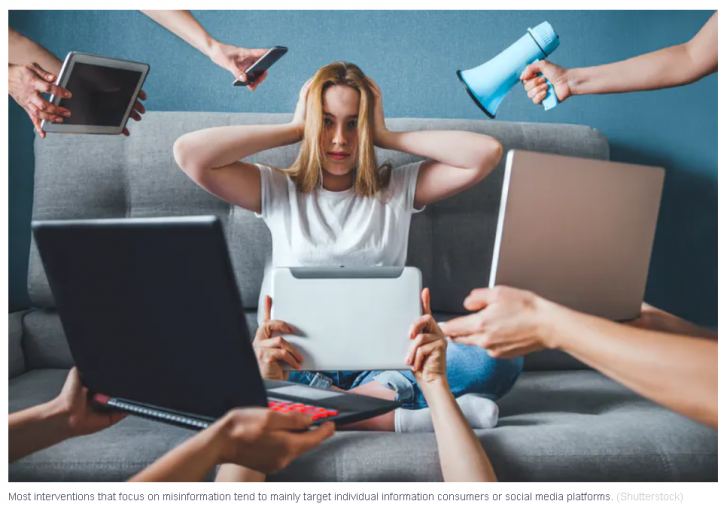Now that over 61 per cent of Canadians have received their first dose of the COVID-19 vaccine, we’re on our way to herd immunity. Unfortunately however, this trend could be at risk as a result of vaccine misinformation, which has made some people hesitant to get a vaccine.
When people try to address vaccine misinformation efforts are often ignored. This is because vaccine hesitancy, like all misinformation, is a complex problem. To address it, we need to think about a wide variety of different contributing factors that are systemic in nature and interact with one another. We can say that this problem is ecological in nature.
We live in an information environment which is increasingly complex and subject to dynamic intersecting systems and processes. Gardening provides a helpful metaphor to help us understand how misinformation can be seen as part of this information ecology.
Sowing the seeds of vaccine science
Using a gardening metaphor, the seed of knowledge is vaccine science. And this seed can be impacted by many different factors.
Individual beliefs and knowledge are the soil in the garden, which needs to be fertile for the seed to take root. In an information ecology, how fertile the soil is for growing ideas about vaccine safety and efficacy will depend on individual history and experiences, education, values and worldview.

Communities and relationships are the helpful or harmful garden visitors (such as pollinators or pests). They determine how much a plant can grow and thrive. Influencers can be pollinators or pests that can help or hinder vaccine information. So can community members, colleagues and people we are exposed to via social media algorithms.
Government regulations and policies are the gardeners who help to weed out bad ideas before they take root. Policies that guide how social media platforms should respond to misinformation, or policies that influence media consolidation, for example, antitrust regulations, are important with respect to weeding misinformation out of the information ecology.
Policies that either strengthen or weaken public education also have a role to play. Citizens need to have a good understanding of science, and access to media outlets that can provide the best information related to vaccines.
Finally, culture is the sun and rain: it surrounds all of us and can help information thrive, or leave it withering and susceptible to misinformation growth. Cultural metaphors like the marketplace of ideas — the assumption that information competition always leads to the best ideas flourishing — can inadvertently create a fertile ground for misinformation to grow.
Misinformation in this metaphor is an invasive species. It takes root when the conditions are favourable, and once established can be very hard to get rid of.
Considering the whole information environment
Most interventions that focus on misinformation tend to mainly target individual information consumers or social media platforms. That is, they rely on people to debunk information when they see it, they stress information and digital literacy for the individual and they focus on technical fixes that platforms can make to their algorithms to stop the spread of misinformation.
These interventions are undoubtedly important, however without government and culture based interventions then individual and platform solutions are less effective – we need all parts of the information ecology to come together. Returning to the garden as a metaphor, if we have good soil, and helpful pollinators, but no gardener to pull weeds, and no light or water, our seed will not grow.
Growing our seeds
What does this mean for those of us who study misinformation? It means that research and initiatives that address individual psychology and beliefs that drive information should continue, along with technological platform based approaches, and community initiatives – like #ScienceUpFirst, an initiative that encourages scientists to participate in public communication about their work.
But in addition to these tactics, scholars and science communicators who want to address vaccine misinformation need to make sure they’re also looking at policy and cultural interventions.
What can this look like? On the policy side, social scientist Joan Donovan’s whole of society approach shows the ways civil society organizations can combat misinformation by working with citizens, public health providers and technology platforms.
Similarly, it’s time for scholars to do more work to understand the connections between, for example, public school funding and misinformation at scale, or media deregulation and misinformation. While journalists tell us they see a connection, finding ways to study these issues is of utmost importance.
On the culture side, we need to think about how we approach cultural frames like the marketplace of ideas. Scholars should illuminate the role these play in giving cover for malicious misinformation. Policy makers and journalists need to discuss freedom of speech in ways that also allow us to address speech harms like misinformation and harassment. This requires understanding and finding better ways to communicate the complex ways that ideas intersect with power and money – which goes beyond a dichotomy of more speech good, less speech bad.
When as much attention is paid to the policy and cultural elements of the misinformation ecosystem as is now paid to the individual and platform elements, we will ensure our seeds of scientific communication get the light, water and tending they need to thrive, and that misinformation is cut back before it has the chance to take root.
Article From: Conversation
Author: Jaigris Hodson, Associate Professor of Interdisciplinary Studies, Royal Roads University

